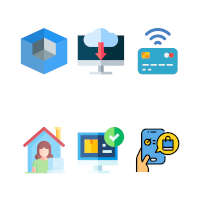Claritas on… The Tech World After Covid-19
The Coronavirus pandemic has hit every industry imaginable in many different ways. In this edition of Claritas on… we are delving into what we think, in our opinion, the tech world could look like after Covid-19. With many businesses and individuals relying on technology, not just for business survival, but for everyday life, these new adoptions have been vital throughout the pandemic and we believe they are here to stay. Have a read.
Artificial intelligence and online shopping
With more and more consumers forced to purchase online throughout the pandemic, the world has readily adapted to a trend that is here for the long haul.
We believe consumers will continue to purchase more goods and services online. As a result, the use of artificial intelligence (AI) will be especially valuable for those within retail and supply chain industries. Through machine learning and advanced data analytics, AI will help companies discover new purchasing patterns and behaviours of customers.
It seems AI robotics will also become a huge trend in delivering products to consumers, as e-commerce giants ramp up their development of robot deliveries to avoid human contact.
Cloud computing
Throughout the pandemic, our partners, Microsoft, reported a 775% spike in cloud services demand. Post Covid-19, cloud-based tech is likely to continue to rise across all types of applications.
As many people have been forced to work from home, the demand for cloud-based services, i.e. video call, has seen a rise like never before. Various cloud service vendors, for example, Zoom, have upgraded their functions, and provided resources to meet this increased demand.
In the future, we can only see demand for this trend continuing to increase as we believe more companies will adopt remote, or hybrid, working policies on an ongoing basis.
Cybersecurity
During lockdown, when thousands of people were forced to work from their homes, private data became available to cybercriminals, due to it not being protected in the right way.
Cybercriminals took advantage of Coronavirus and saw it as an opportunity to initiate their own online viruses. Examples of such threats include fake domains for Covid-19 information, phishing emails promising virus protection kits, and false information on cancelled events.
In addition, there has been an increase in ransomware attacks on health institutions and an increase in the hacking of research centres in a bid to steal information about possible vaccinations for Covid-19.
Going forward, we think cybersecurity will be at the top of many companies’ agendas.
Digital and contactless payments
With the fear that cash might carry the virus, a lot of businesses took measures to go cashless, encouraging digital and contactless payments.
Now, contactless, and digital payments, either in the form of cards or e-wallets, are the recommended payment method to avoid the spread of Covid-19. Additionally, the contactless limit rose to £45 from £30 in May, and as time goes on, we can only see this increasing – potentially to a cashless society in the not-so-distant future.
Remote working, learning, and entertainment
When the pandemic was at its peak, many employees worked from home on a daily basis, with many offices staying empty for the foreseeable. Not to mention, in April, 191 countries announced school or university closures, impacting 1.57 billion students. Entertainment, leisure and recreational facilities and classes were also closed.
Remote working is enabled by technologies including virtual private networks (VPNs), voice over internet protocols (VoIPs), virtual meetings, cloud technology, work collaboration tools, and even facial recognition technologies that enable a person to appear before a virtual background to preserve the privacy of the home. Remote working also has other benefits, as well as preventing the spread of viruses, it saves on commuting time and provides more flexibility. We believe this will continue into the future.
To combat the educational closures, many institutions started offering courses online to ensure education was not disrupted by quarantine measures. Technologies involved in remote learning are similar to those for remote working and also include virtual reality, augmented reality, 3D printing and artificial-intelligence-enabled robot teachers.
And it doesn’t stop there. In the world of entertainment and leisure, many recreational classes, groups, friends, and family took to socialising and joining in online events.
At Claritas, we believe this will be a permanent shift as the population has gotten used to harnessing the power of technology for their personal lives, providing ease and convenience.
3D printing
It’s safe to say that throughout Coronavirus, the power of 3D printing was realised. From creating ventilators, to key medical equipment, such as valves, in a matter of hours, in a time of need. We think 3D printing will be utilised much more, especially in the medical industry.
A key benefit of 3D printing? It offers flexibility in production. For example, the same printer can produce different products based on different design files and materials, and simple parts can be made onsite quickly without a lengthy procurement process and a long wait for the shipment to arrive.
We’d love to hear your opinion. Do you think these technology trends will last in a post-Covid-19-world? Or do you think once the pandemic lifts, they will be a thing of the distant past?



